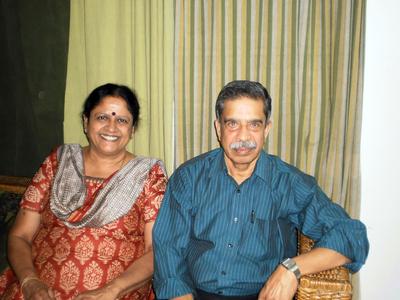He is leading a retired life but spends most of his time and energy in bringing necessary improvement to the community. He is affable, determined, disgruntled with the official apathy yet hopeful. He is the ‘military man’ of HSR Layout, meet Brigadier R S Murthy, 68, Vice President, Federation of Residents Welfare Associations in HSR layout.

Brig Murthy with his wife Lalitha.
Pic: Deepthi M S
He lives with his wife Lalitha Murthy, 61, who is a teacher. Learning to use the Internet seems to be their latest pursuit. With Brigadier’s transfers to various parts of the country, Lalitha says that their house in HSR is their 24th house and this is the longest they have lived in one house. Brigadier Murthy talks about his life in the armed forces and what concerns him about the community.
When did you join the Indian Army?
I joined the Indian military in 1963. I have fought for India in 1961 and 1971 wars. I spent 33 years in the Army. I retired in 1997.
After retirement, I worked for 8 years for TATA group. Being an Accredited Management teacher (Soft Skills training), I am a visiting faculty for business schools like The Institute of Chartered Accountants of India (ICAI), Christ University and others. I’m also a part of the Board of Advisers for Cambridge Group of Schools.
What about your family?
I have two daughters. Both have been married and are living abroad. I have one grand daughter. My family has travelled with me almost everywhere. Today, I can very well say that they can adjust and adapt to any situation they face.
I’m very fond of music. I listen to a lot of Carnatic and Hindustani music. I like to go for walks, I walk for about 4- 5 kms everyday. I spent time in writing and also enjoy playing golf. Off-late both of us are learning more about Internet. I like narrating stories to my grand daughter over video chats. It is something new for us.
My wife and I are very fond of travelling. We like going on holidays. There is nothing as a favourite destination but I like going to Roorkee, it is in Uttarakhand. Have a lot of friends there. I go there quite often.
Do you find major difference between the army surroundings and the present surroundings?
Army has a different social fabric. The sense of community feeling is at its best there. I do not see much of it here. For example, in the army festivals are seen as a time to interact with the people living around you. Here, it is viewed as a holiday to relax, people do not have time for their own kids, forget about spending time with neighbours and taking part in community events. I do not blame them either as their work-life is so hectic. But there should be some amount of social life.
What motivates you to keep yourself involved in the community?
I enjoy what I am doing. I have been happy and satisfied with my army life, now I want to contribute something back to the society. Something has to been done regarding the problems, someone has to take a stand. This way, I am doing something for my society.
What changes would you like to bring-in for the society?
I feel that discipline and the sense of responsibility is missing in people. I personally think that everyone should be a part of the army at some point or the other, or atleast should be a part of NCC. It brings in some kind of discipline. That would bring in a lot of stability and a sense of mutual responsibility. Children need to be brought up in balanced way, as they are the future.
What do you think about HSR Layout?
There is a lot of scope for improvement in this area. There are a lot of things that needs to be taken care of . One of the main thing is the garbage disposal process. There is no proper system of garbage management. And the other menace are the hawkers on road sides. They cause so much of inconvenience to for vehicles and pedestrians. Even if the police chase them away, they are back in few hours.
What is your opinion on the BWSSB work on 27th main?
The 27th main road is like the main artery to this layout. Now the road is left in a pathetic condition. I want to ask what government means when they say planning for a particular project? These officials have started the project, dig up the whole road and then say they cannot go any further as they have rocks coming in the way. Why didn’t they take satellite pictures of the place?
What do you think is the solution?
The government needs to work keeping in mind the interests and safety of the people. Citizens should come together as a community and show interest in doing something for the development of the surroundings. Today, any information can be got through RTI. And our society has everything required in terms of resources. The only problem is, it has not made use of resources properly. Our politicians and government officials have all the power but do not execute it wisely.
⊕